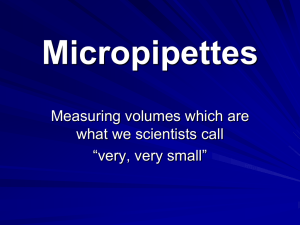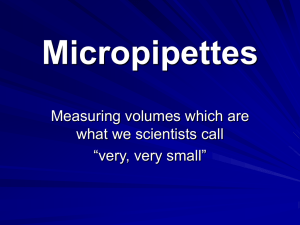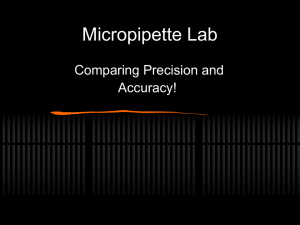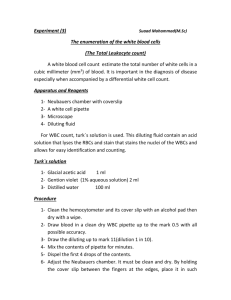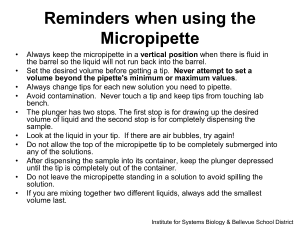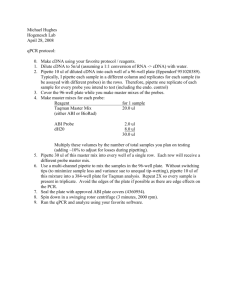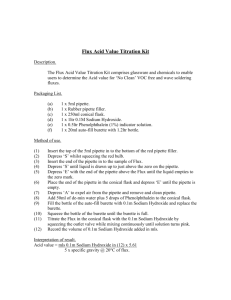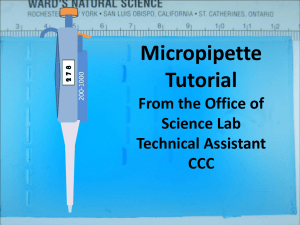Pipette Use and Maintenance
advertisement
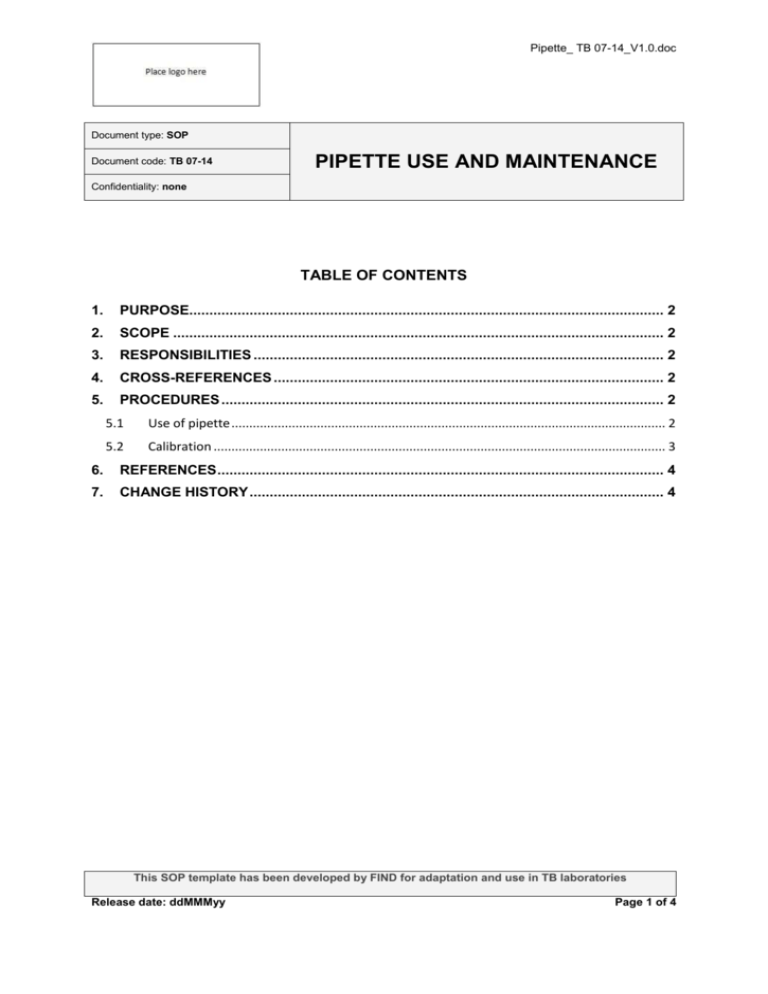
Pipette_ TB 07-14_V1.0.doc Document type: SOP Document code: TB 07-14 PIPETTE USE AND MAINTENANCE Confidentiality: none TABLE OF CONTENTS 1. PURPOSE...................................................................................................................... 2 2. SCOPE .......................................................................................................................... 2 3. RESPONSIBILITIES ...................................................................................................... 2 4. CROSS-REFERENCES ................................................................................................. 2 5. PROCEDURES .............................................................................................................. 2 5.1 Use of pipette .......................................................................................................................... 2 5.2 Calibration ............................................................................................................................... 3 6. REFERENCES ............................................................................................................... 4 7. CHANGE HISTORY ....................................................................................................... 4 This SOP template has been developed by FIND for adaptation and use in TB laboratories Release date: ddMMMyy Page 1 of 4 Pipette_TB 07-14_V1.0.doc 1. PURPOSE This SOP describes the use, calibration and maintenance of variable volume micropipettes. Optimal operation of pipettes is achieved through regular calibration and proper maintenance. Poor calibration may lead to a malfunction that can directly affect specimen testing, specimen integrity, or safety. 2. SCOPE This SOP relates to all procedures involving use of micropipettes performed in the ____________ TB Laboratory. 3. RESPONSIBILITIES All staff members working in the ____________ TB Laboratory are responsible for the implementation of this operating procedure. All users of this procedure who do not understand it or are unable to carry it out as described are responsible for seeking advice from their supervisor. 4. CROSS-REFERENCES See: Document Matrix_TB 01-01_V1.0.doc Location: 5. PROCEDURES 5.1 Use of pipette Refer to the operating manual provided with your micropipette for full details of its operation. Prior to use, the pipette should be checked for spilled substances and wiped with an appropriate disinfectant. Dispensed volumes are set by manually adjusting a micrometer attached directly to a digital volume indicator, which reads in microlitres. Turn volume adjustment knob to 1/3 revolution above desired setting, then turn knob counterclockwise until intended volume is displayed. Dialing down to the desired volume prevents mechanical backlash from affecting accuracy. Attach new disposable pipette tip to shaft by pressing down with just enough force to make airtight seal. Press plunger to first stop. Holding pipette vertically, immerse tip in liquid to be pipetted. Allow button to slowly return to up position. Pause briefly to assure that full volume has entered tip, then withdraw tip from sample liquid. To dispense sample, touch tip against side wall of receiving vessel and slowly depress plunger to first stop. Wait 1-2 seconds, then depress plunger to second stop to expel all liquid. Withdraw tip with plunger fully depressed and tip against vessel wall. Page 2 of 4 Pipette_TB 07-14_V1.0.doc Allow plunger to return to up position. Discard tip into appropriate container by pressing discard button. If pipetting acids or corrosive agents, disassemble pipette on completion of task to inspect and (if necessary) clean piston, shaft, and seal assemblies with distilled water or isopropyl alcohol. For pipetting of potentially infectious liquids, filtered pipette tips must be used at all times. Contaminated pipette tips must be discarded into a sharps disposal container situated in the Biological Safety Cabinet. 5.2 Calibration The pipette is checked annually for accuracy using the following procedure. The distilled water, pipette, and pipette tips must be equilibrated to the same temperature. Weigh at 20-25oC. Avoid drafts. Dispense distilled water into a vessel on the balance with the weight set to 0. Use a slow careful motion when aspirating with the pipette. Use a pre-rinsed pipette tip, i.e. discard the first amount pipetted. This wets the inside of the pipette tip. The volume from a dry tip and a pre-rinsed tip is different. Dispense ten volumes of distilled water from the pipette into the glass container, according to the specified volumes for each pipette, given on the Pipette Calibration form. Use: Pipette Calibration_form.xls Location: Enter the weights into the electronic version of the form which automatically calculates whether the pipette has passed or failed calibration. Refer to the pipette Instruction Manual for further details. The pipette needs calibration if it is not within the acceptable range of accuracy stated in the manufacturer’s manual and FAIL is reported on the spreadsheet. Repeat the calibration procedure once and if a second failure is achieved, issue an Equipment Failure Report. If a pipette fails calibration or becomes broken or damaged an Equipment Failure Report must be completed and the service representative contacted for servicing and repair. An Equipment Failure Notice must be placed on the pipette indicating that use is prohibited. .Use: Equipment Failure Notice_form.doc Equipment Failure Report_form.doc Location: Refer to the Instruction Manual for troubleshooting. Page 3 of 4 Pipette_TB 07-14_V1.0.doc 6. REFERENCES Procedure for Evaluating Accuracy and Precision of RAININ pipettes. Factory-Approved Method for Using Gravimetric Anaysis. Rainin Instrument, LLC. World Health Organization. Maintenance and repair of laboratory, diagnostic imaging and hospital equipment. Geneva: WHO; 1994. World Health Organization. Manual of basic techniques for a health laboratory. 2nd ed. Geneva: WHO; 2003. World Health Organization. Regional Office for the Eastern Mediterranean. Basics of quality assurance for intermediate and peripheral laboratories. 2nd ed. Cairo; 2002. 7. CHANGE HISTORY New version # / date Old version # / date No. of changes Description of changes Source of change request Page 4 of 4

